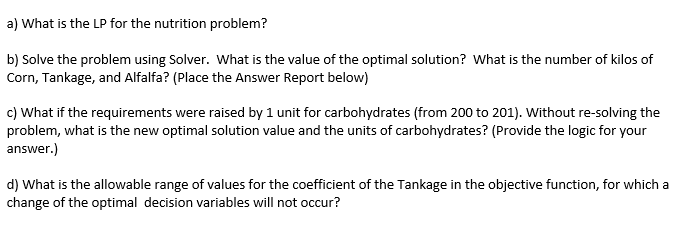Answered step by step
Verified Expert Solution
Question
1 Approved Answer
please help set up table for solver for b, c & d in excel. Final Prob 3). After a grueling year of work, you (Padcha)


please help set up table for solver for b, c & d in excel.
Final Prob 3). After a grueling year of work, you (Padcha) decide you need absolute peace and quiet for about a month (February). You visit San Pedro de Atacama in the Atacama dessert of Chile, one of the most pristine and beautiful spots on earth. Every morning you have an espresso with a Swiss veterinarian, Dieter, that has retired there and maintains a small hotel and cafe. After week 2 of peace and quiet you become restless for a more meaningful existence. In a conversation Dieter you learn that he also raises Llama's, Alpacas, and Vicuas (all members of the Camel Family) for their wool. The conversation follow-- Dieter: "Padcha, I have this problem related to the nutrition of my animals. I know the nutritional content of the feeds I have available (see the Daily Nutritional Requirements for Animals table). I also know the cost of a kilogram of each feed (see table). I would love to have a way of selecting a mix of Corn, Tankage, and Alfalfa that minimizes my daily cost of providing good nutrition for my animals." Padcha: "Dieter, I think I might be able to help. In LP optimization, there is a problem that is called the nutrition problem. Of course, it is not only about nutrition, it's also about allocating available resources, in an optimal way (minimal cost), to satisfy requirements. You can image, that there are a lot of problems like that in business. A typical constraint, say for carbohydrates, would read--the number of kilos of Corn times 90, plus the number of kilos of Tankage times 20, plus the number of kilos of Alfalfa times 40 must equal a minimum 200 units of carbohydrates. The constraint shows how we use the resources/decision variables (kilos of Corn, etc.) to satisfy nutritional needs. Carbohydrates Protein Vitamins $Cost of feed/Kg. Daily Nutritional Requirements for Animals Kg. Corn Kg. Tankage Kg. Alfalfa Min. Daily Reqs. 90 20 40 200 80 60 180 30 10 $35 60 150 $25 20 $30 a) What is the LP for the nutrition problem? b) Solve the problem using Solver. What is the value of the optimal solution? What is the number of kilos of Corn, Tankage, and Alfalfa? (Place the Answer Report below) c) What if the requirements were raised by 1 unit for carbohydrates (from 200 to 201). Without re-solving the problem, what is the new optimal solution value and the units of carbohydrates? (Provide the logic for your answer.) d) What is the allowable range of values for the coefficient of the Tankage in the objective function, for which a change of the optimal decision variables will not occur? Final Prob 3). After a grueling year of work, you (Padcha) decide you need absolute peace and quiet for about a month (February). You visit San Pedro de Atacama in the Atacama dessert of Chile, one of the most pristine and beautiful spots on earth. Every morning you have an espresso with a Swiss veterinarian, Dieter, that has retired there and maintains a small hotel and cafe. After week 2 of peace and quiet you become restless for a more meaningful existence. In a conversation Dieter you learn that he also raises Llama's, Alpacas, and Vicuas (all members of the Camel Family) for their wool. The conversation follow-- Dieter: "Padcha, I have this problem related to the nutrition of my animals. I know the nutritional content of the feeds I have available (see the Daily Nutritional Requirements for Animals table). I also know the cost of a kilogram of each feed (see table). I would love to have a way of selecting a mix of Corn, Tankage, and Alfalfa that minimizes my daily cost of providing good nutrition for my animals." Padcha: "Dieter, I think I might be able to help. In LP optimization, there is a problem that is called the nutrition problem. Of course, it is not only about nutrition, it's also about allocating available resources, in an optimal way (minimal cost), to satisfy requirements. You can image, that there are a lot of problems like that in business. A typical constraint, say for carbohydrates, would read--the number of kilos of Corn times 90, plus the number of kilos of Tankage times 20, plus the number of kilos of Alfalfa times 40 must equal a minimum 200 units of carbohydrates. The constraint shows how we use the resources/decision variables (kilos of Corn, etc.) to satisfy nutritional needs. Carbohydrates Protein Vitamins $Cost of feed/Kg. Daily Nutritional Requirements for Animals Kg. Corn Kg. Tankage Kg. Alfalfa Min. Daily Reqs. 90 20 40 200 80 60 180 30 10 $35 60 150 $25 20 $30 a) What is the LP for the nutrition problem? b) Solve the problem using Solver. What is the value of the optimal solution? What is the number of kilos of Corn, Tankage, and Alfalfa? (Place the Answer Report below) c) What if the requirements were raised by 1 unit for carbohydrates (from 200 to 201). Without re-solving the problem, what is the new optimal solution value and the units of carbohydrates? (Provide the logic for your answer.) d) What is the allowable range of values for the coefficient of the Tankage in the objective function, for which a change of the optimal decision variables will not occurStep by Step Solution
There are 3 Steps involved in it
Step: 1

Get Instant Access to Expert-Tailored Solutions
See step-by-step solutions with expert insights and AI powered tools for academic success
Step: 2

Step: 3

Ace Your Homework with AI
Get the answers you need in no time with our AI-driven, step-by-step assistance
Get Started


